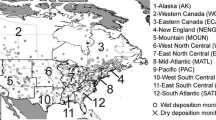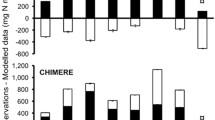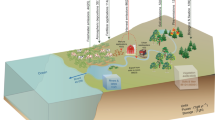Abstract
Human activities, related primarily to agricultural practices and the combustion of fossil fuels for energy and transport, have caused steep increases in global emissions of reactive nitrogen (Nr) over the last 50 years (e.g., Galloway et al. Biogeochemistry, 70(2), 153–226, 2004, Science, 320, 889–892, 2008). Atmospheric nitrogen (N) deposition derived from these sources represents a major threat to natural ecosystems around the world, leading to changes in structure, function and the associated biodiversity (e.g. Phoenix et al. Global Change Biology, 12, 470–476, 2006; Bobbink et al. Ecological Applications, 20, 30–59, 2010). Although substantial progress has been made in past decades, especially in Europe and North America, major uncertainties remain regarding the global perspective. In the last 30 years, Europe and North America have made great progress in assessing the problem, although the knowledge base is greater for impacts on flora than fauna; in many other parts of the world, however, the required datasets and assessments in many cases do not yet exist. This chapter summarizes the approach taken in the Workshop on Nitrogen Deposition, Critical Loads and Biodiversity and outlines the contents and structure of the book.
Access provided by Autonomous University of Puebla. Download chapter PDF
Similar content being viewed by others
Keywords
1.1 Background and Problem
Increases in nitrogen (N) deposition to sensitive ecosystems in broad areas of Europe, North America, and parts of Asia, over the last 50 years have resulted in losses of plant diversity, shifts in plant community composition, alteration of food webs and changes in ecosystem services (Bobbink et al. 2010; Sutton et al. 2011) . Global scale modelling using current N emission scenarios indicates that most regions around the globe will have increased rates of atmospheric N deposition over the next decades, causing concern about significant impacts on global biodiversity (Dentener et al. 2006). Increased N emissions will also have impacts on human health (e.g. as precursors of PM2.5 and ozone) and adversely affect crop yields though increased ozone concentrations (Sutton et al. 2011) . However, not all the environmental impacts of N deposition are negative, for example, in some cases N deposition can also have beneficial effects on crop yields and also increase carbon (C) sequestration in certain vegetation types through its fertilizing effect (e.g., Butterbach-Bahl et al. 2011). This volume considers impacts on biodiversity in the context of these other important policy relevant impacts.
In some parts of the world, such as Europe and Canada, international concern over acidification and eutrophication impacts prompted the development of an effects threshold approach for assessing the impacts of acidic deposition, including N deposition, known as “critical loads” (CLs) . The CLs approach has been a valuable tool to assess present and future risks of adverse effects of N deposition on biodiversity. Critical load exceedance for N has been used as an indicator by the Streamlining European 2010 Biodiversity Indicators (EEA 2007; SEBI 2010) for assessing, reporting on and communicating achievement of the 2010 target to halt biodiversity loss under the CBD . However, it is unclear if CLs and their exceedance can be adopted usefully for global application under the CBD.
In addition to Europe and North America, N deposition is above or approaching critical loads in parts of Asia, Africa and Latin America. However, insufficient studies exist on the effects of N deposition in these regions to provide a basis for comprehensive application of the CLs approach. Other shortcomings in several areas currently hamper adoption of the critical thresholds approach and assessment of N impacts in general :
-
Significant uncertainty in total deposition estimates around the globe, particularly for dry deposition;
-
Uncertainty about the relationship between biodiversity loss and N dynamics and the translation into critical loads;
-
Uncertainty in the global transferability of critical level values for ammonia and nitrogen oxides concentrations developed in Europe;
-
Need for more field-based evidence for biodiversity effects, where plant studies are often lacking in many regions and studies on animals and other groups are even scarcer;
-
More persuasive indicators of biodiversity loss in areas that have exceeded critical N loads are required on a global scale;
-
Further development of tools/indicators for N induced biodiversity loss should ideally take account of impacts of N addition on valuable ecosystem services such as C sequestration and regulating services related to soil and water quality, in interaction with climate change .
1.2 Workshop Approach
The Expert Workshop considered five key topic areas in plenary and breakout sessions. Overarching themes included the exchange of information between different regions and disciplines and how measurements and approaches for assessing N deposition and biodiversity loss can be harmonized at a global scale . Key topic areas, serving as the focus for plenary and Working Group sessions included:
-
i.
Progress in monitoring and modelling estimates of N deposition at local, regional and global scales ;
-
ii.
Factors affecting N deposition impacts on terrestrial and aquatic ecosystem biodiversity;
-
iii.
Development of the critical loads concept and its application to different regions of the world ;
-
iv.
Importance of N deposition effects on ecosystem services and interactions with other pollutants and climate change ;
-
v.
Implications of current knowledge of N deposition and its impacts pertaining to policy, management and capacity building needs.
1.3 Structure and Purpose of Book
This introduction is followed by a series of sections based on the five key topic areas that served as the focal points for plenary and Working Group sessions. Each section contains an updated version of the background document that was written before the workshop to inform the discussions in each session, followed by the papers submitted by the speakers of the workshop on the key topics. Topics (iv) and (v) have been combined into one section. The final section reports the conclusions and recommendations from the breakout groups and ends with a synthesis and summary for policy makers.
This book is intended to serve as a resource for:
-
Scientists involved from both air pollution and biodiversity fields;
-
Policy makers in many countries globally, including especially those with an interest in the UN Convention on Biological Diversity and the UNECE Convention on Long-range Transboundary Air Pollution;
-
Agencies responsible for conservation, land management, and natural resources;
-
Environment and pollution control agencies;
-
Environmental managers;
-
Post graduates and undergraduates.
References
Bobbink, R., Hicks, K., Galloway, J., Spranger, T., Alkemade, R., Ashmore, M., Bustamante, M., Cinderby, S., Davidson, E., Dentener, F., Emmett, B., Erisman, J. W., Fenn, M., Gilliam, F., Nordin, A., Pardo, L., & de Vries, W. (2010). Global assessment of nitrogen deposition effects on terrestrial plant diversity: A synthesis. Ecological Applications, 20, 30–59.
Butterbach-Bahl, K., Nemitz, E., Zaehle, S., Billen, G., Boeckx, P., Erisman, J. W., Garnier, J., Upstill-Goddard, R., Kreuzer, M., Oenema, O., Reis, S., Schaap, M., Simpson, D., de Vries, W., Winiwarter, W., & Sutton M. A. (2011). Nitrogen as a threat to the European greenhouse balance. In: M. A. Sutton, C. M. Howard, J. W. Erisman, G. Billen, A. Bleeker, P. Grennfelt, H. van Grinsven, & B. Grizzetti. (Eds.), The European nitrogen assessment (Chapter 19). Cambridge University Press.
Dentener, F., Drevet, J., Lamarque, J. F., Bey, I., Eickhout, B., Fiore, A. M., Hauglustaine, D., Horowitz, L. W., Krol, M., Kulshrestha, U. C., Lawrence, M., Galy-Lacaux, C., Rast, S., Shindell, D., Stevenson, D., Noije, T. V., Atherton, C., Bell, N., Bergman, D., Butler, T., Cofala, J., Collins, B., Doherty, R., Ellingsen, K., Galloway, J., Gauss, M., Montanaro, V., Müller, J. F., Pitari, G., Rodriguez, J., Sanderson, M., Solmon, F., Strahan, S., Schultz, M., Sudo, K., Szopa, S., & Wild, O. (2006). Nitrogen and sulfur deposition on regional and global scales: A multimodel evaluation. Global Biogeochemical Cycles, 20, 21.
EEA. (2007) Halting the loss of biodiversity by 2010: Proposal for a first set of indicators to monitor progress in Europe. European Environment Agency Technical Report 11/2007. http://www.eea.europe.eu.
Galloway, J. N., Dentener, F. J., Capone, D. G., Boyer, E. W., Howarth, R. W., Seitzinger, S. P., Asner, G. P., Cleveland, C. C., Green, P. A., Holland, E. A., Karl, D. M., Michaels, A. F., Porter, J. H., Townsend, A. R., & Vorosmarty, C. J. (2004). Nitrogen cycles: Past, present, and future. Biogeochemistry, 70(2), 153–226.
Galloway, J. N., Townsend, A. R., Erisman, J. W., Bekunda, M., Cai, Z., Freney, J. R., Martinelli, L. A., Seitzinger, S. P., & Sutton, M. A. (2008). Transformation of the nitrogen cycle: Recent trends, questions, and potential solutions. Science, 320, 889–892.
Phoenix, G. K., Hicks, W. K., Cinderby, S., Kuylenstierna, S. C. I., Stock, W. D., Dentener, F. J., Giller, K. E., Austin, A. T., Lefroy, R. D. B., Gimeno, B. S., Ashmore, M. R., & Ineson, P. (2006). Atmospheric nitrogen deposition in world biodiversity hotspots: The need for a greater global perspective in assessing N deposition impacts. Global Change Biology, 12, 470–476.
SEBI. (2010). Streamlining European 2010 Biodiversity Indicators. http://ec.europa.eu/environment/nature/knowledge/eu2010_indicators/index_en.htm; http://biodiversity.europa.eu/topics/sebi-indicators; http://www.bipnational.net/IndicatorInitiatives/SEBI2010.
Sutton, M. A., Howard, C. M., Erisman, J. W., Billen, G., Bleeker, A., Grennfelt, P., van Grinsven, H., & Grizzetti, B. (Eds.). (2011). The European nitrogen assessment. Cambridge University Press.
Author information
Authors and Affiliations
Corresponding author
Editor information
Editors and Affiliations
Rights and permissions
Copyright information
© 2014 Springer Science+Business Media Dordrecht
About this chapter
Cite this chapter
Hicks, W., Haeuber, R., Sutton, M. (2014). Nitrogen Deposition, Critical Loads and Biodiversity: Introduction. In: Sutton, M., Mason, K., Sheppard, L., Sverdrup, H., Haeuber, R., Hicks, W. (eds) Nitrogen Deposition, Critical Loads and Biodiversity. Springer, Dordrecht. https://doi.org/10.1007/978-94-007-7939-6_1
Download citation
DOI: https://doi.org/10.1007/978-94-007-7939-6_1
Published:
Publisher Name: Springer, Dordrecht
Print ISBN: 978-94-007-7938-9
Online ISBN: 978-94-007-7939-6
eBook Packages: Earth and Environmental ScienceEarth and Environmental Science (R0)




